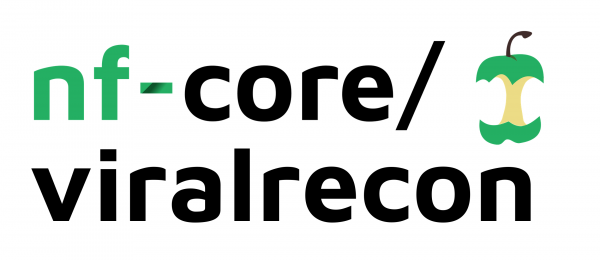nfcore/viralrecon is a bioinformatics analysis pipeline used to perform assembly and intra-host/low-frequency variant calling for viral samples. The pipeline supports short-read Illumina sequencing data from both shotgun (e.g. sequencing directly from clinical samples) and enrichment-based library preparation methods (e.g. amplicon-based: ARTIC SARS-CoV-2 enrichment protocol; or probe-capture-based).
The pipeline is built using Nextflow, a workflow tool to run tasks across multiple compute infrastructures in a very portable manner. It comes with Docker containers making installation trivial and results highly reproducible.
On release, automated continuous integration tests run the pipeline on a full-sized dataset on the AWS cloud infrastructure. This ensures that the pipeline runs on AWS, has sensible resource allocation defaults set to run on real-world datasets, and permits the persistent storage of results to benchmark between pipeline releases and other analysis sources. The results obtained from the full-sized test can be viewed on the nf-core website.
The pipeline has numerous options to allow you to run only specific aspects of the workflow if you so wish. For example, you can skip the host read filtering step with Kraken 2 with --skip_kraken2 or you can skip all of the assembly steps with the --skip_assembly parameter. See the usage docs for all of the available options when running the pipeline.
- Download samples via SRA, ENA or GEO ids (
ENA FTP; if required) - Merge re-sequenced FastQ files (
cat) - Read QC (
FastQC) - Adapter trimming (
fastp) - Removal of host reads (
Kraken 2; optional) - Variant calling
- Read alignment (
Bowtie 2) - Sort and index alignments (
SAMtools) - Primer sequence removal (
iVar; amplicon data only) - Duplicate read marking (
picard; optional) - Alignment-level QC (
picard,SAMtools) - Genome-wide and amplicon coverage QC plots (
mosdepth) - Choice of multiple variant calling and consensus sequence generation routes (
iVar variants and consensus||BCFTools,BEDTools) - Intersect variants across callers (
BCFTools)
- Read alignment (
- De novo assembly
- Present QC and visualisation for raw read, alignment, assembly and variant calling results (
MultiQC)
Numerous QC and reporting steps are included in the pipeline in order to collate a full summary of the analysis within a single MultiQC report. You can see an example MultiQC report here, generated using the parameters defined in this configuration file. The pipeline was run with these samples, prepared from the ncov-2019 ARTIC Network V1 amplicon set and sequenced on the Illumina MiSeq platform in 301bp paired-end format.
-
Install
nextflow -
Install any of
Docker,SingularityorPodmanfor full pipeline reproducibility (please only useCondaas a last resort; see docs) -
Download the pipeline and test it on a minimal dataset with a single command:
nextflow run nf-core/viralrecon -profile test,<docker/singularity/podman/conda/institute>
- Please check nf-core/configs to see if a custom config file to run nf-core pipelines already exists for your Institute. If so, you can simply use
-profile <institute>in your command. This will enable eitherdockerorsingularityand set the appropriate execution settings for your local compute environment. - If you are using
singularitythen the pipeline will auto-detect this and attempt to download the Singularity images directly as opposed to performing a conversion from Docker images. If you are persistently observing issues downloading Singularity images directly due to timeout or network issues then please use the--singularity_pull_docker_containerparameter to pull and convert the Docker image instead. It is also highly recommended to use theNXF_SINGULARITY_CACHEDIRorsingularity.cacheDirsettings to store the images in a central location for future pipeline runs. - If you are using
conda, it is highly recommended to use theNXF_CONDA_CACHEDIRorconda.cacheDirsettings to store the environments in a central location for future pipeline runs.
- Please check nf-core/configs to see if a custom config file to run nf-core pipelines already exists for your Institute. If so, you can simply use
-
Start running your own analysis!
-
Typical command for shotgun analysis:
nextflow run nf-core/viralrecon \ --input samplesheet.csv \ --genome 'MN908947.3' \ -profile <docker/singularity/podman/conda/institute> -
Typical command for amplicon analysis:
nextflow run nf-core/viralrecon \ --input samplesheet.csv \ --genome 'MN908947.3' \ --protocol amplicon \ --primer_bed ./nCoV-2019.artic.V3.bed \ --skip_assembly \ -profile <docker/singularity/podman/conda/institute> -
Typical command for downloading public data:
nextflow run nf-core/viralrecon \ --public_data_ids ids.txt \ -profile <docker/singularity/podman/conda/institute>
NB: The commands to obtain public data and to run the main arm of the pipeline are completely independent. This is intentional because it allows you to download all of the raw data in an initial pipeline run (
results/public_data/) and then to curate the auto-created samplesheet based on the available sample metadata before you run the pipeline again properly. -
See usage docs for all of the available options when running the pipeline.
The nf-core/viralrecon pipeline comes with documentation about the pipeline: usage and output.
These scripts were originally written by Sarai Varona, Miguel Juliá and Sara Monzon from BU-ISCIII and co-ordinated by Isabel Cuesta for the Institute of Health Carlos III, Spain. Through collaboration with the nf-core community the pipeline has now been updated substantially to include additional processing steps, to standardise inputs/outputs and to improve pipeline reporting; implemented primarily by Harshil Patel from The Bioinformatics & Biostatistics Group at The Francis Crick Institute, London.
Many thanks to others who have helped out and contributed along the way too, including (but not limited to)*:
* Listed in alphabetical order
If you would like to contribute to this pipeline, please see the contributing guidelines.
For further information or help, don't hesitate to get in touch on the Slack #viralrecon channel (you can join with this invite).
If you use nf-core/viralrecon for your analysis, please cite it using the following doi: 10.5281/zenodo.3901628
An extensive list of references for the tools used by the pipeline can be found in the CITATIONS.md file.
You can cite the nf-core publication as follows:
The nf-core framework for community-curated bioinformatics pipelines.
Philip Ewels, Alexander Peltzer, Sven Fillinger, Harshil Patel, Johannes Alneberg, Andreas Wilm, Maxime Ulysse Garcia, Paolo Di Tommaso & Sven Nahnsen.
Nat Biotechnol. 2020 Feb 13. doi: 10.1038/s41587-020-0439-x.









